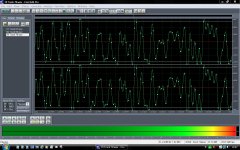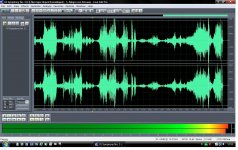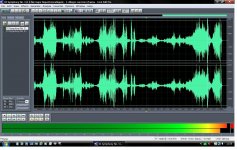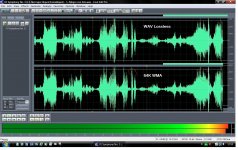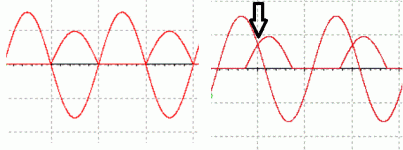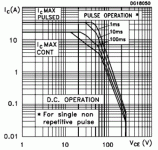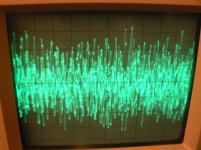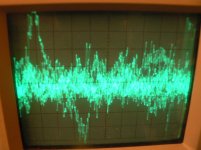pic1 shows avg@-27.98
pic5 shows average @ -8.80
Setting the volume attenuator for these two quite different tracks will result in a 19.18dB difference in the predicted maximum voltage needed to be supplied to the speakers.
for example: if one attenuator setting shows 1.2Vac of 120Hz test tone, the other will show 12Vac of 120Hz test tone.
That's a 100:1 difference in required power prediction for just these two examples.
Don't let Pano and others delude you in to thinking that average levels do not matter.
The argument that this 0dBfs is a fixed hard ceiling voltage level allows power predictions is flawed, even restricting it to digital only signals.
I wonder what the average to peak ratios look like in well recorded 192kb/s & 24bit resolution?
pic5 shows average @ -8.80
Setting the volume attenuator for these two quite different tracks will result in a 19.18dB difference in the predicted maximum voltage needed to be supplied to the speakers.
for example: if one attenuator setting shows 1.2Vac of 120Hz test tone, the other will show 12Vac of 120Hz test tone.
That's a 100:1 difference in required power prediction for just these two examples.
Don't let Pano and others delude you in to thinking that average levels do not matter.
The argument that this 0dBfs is a fixed hard ceiling voltage level allows power predictions is flawed, even restricting it to digital only signals.
I wonder what the average to peak ratios look like in well recorded 192kb/s & 24bit resolution?
Hi Back, I've read that Rod Elliot article before it is an interesting and informative one. But I don't think you are getting the concept of the 120Hz sine signal. 120Hz is a nominal value chosen because the average DMM is most accurate around that frequency, and the 12db is chosen for calculation simplicity.... it is not a test about music power, it is a test about what voltage level clipping will occur at.
We are talking about digital reproduction here. The whole concept is based around the fact that you can't have a level higher than 0db from the digital source. You are not going to be able to put a 2V 120Hz sine wave and a 2V 1Khz sine wave superimposed onto your digital medium and get 4V outThe limit is still 2V, so regardless of the make up of the waveform it is still going to be max 2V out of the digital source. It is a hard limit

Tony.
i thought the purpose of all this was for as to know how big amp we need.
the result for me was 150watts/3ohm or 50 watts/8ohm.
this kind of of power is only a joke for my speakers.
according to elliot and his 4x i would need an 600watt amp
which is what is the one pair of amps i own and i hear a little distortion
at full power which logical.
a little bigger amps and there is no distortion all the way to the limit.
I prefer to play it loud too 
Maybe it's the increased ambient noise in a car that makes
compressed music sound better.
In my experience listening to dynamic music can be troublesome when there's
a lot of ambient noise.
Depending on your loudspeakers it also matters at what frequencies the loudest passages have the most energy.
My loudspeakers are small bassreflex 2-ways with 6.5" woofer,
so below the port-resonance the unloading can be a problem when playing loud.
The "Echoes" track from David Gilmour's album 'Live at the Royal Albert Hall"
for example has a passage where there's a huge amount of lf-energy
-it sounds to me the p.a. was clipping-
that literally startled me when i first heard it, an unsuspecting listener
could easily send his/her woofercones airborne when playing it loud.
Maybe it's the increased ambient noise in a car that makes
compressed music sound better.
In my experience listening to dynamic music can be troublesome when there's
a lot of ambient noise.
Depending on your loudspeakers it also matters at what frequencies the loudest passages have the most energy.
My loudspeakers are small bassreflex 2-ways with 6.5" woofer,
so below the port-resonance the unloading can be a problem when playing loud.
The "Echoes" track from David Gilmour's album 'Live at the Royal Albert Hall"
for example has a passage where there's a huge amount of lf-energy
-it sounds to me the p.a. was clipping-
that literally startled me when i first heard it, an unsuspecting listener
could easily send his/her woofercones airborne when playing it loud.
My room is about 300 cubic feet
Hear Yea, Hear Yea, our grand moderator locked himself in the closet again.
Probably meant 300sqft.
(me 18' x <12.5' x <8.5' high, is ~225sqft, largest bedroom on the 2nd floor, cause i have esl2905 and tiny willy amp)
pic1 shows avg@-27.98
pic5 shows average @ -8.80
Setting the volume attenuator for these two quite different tracks will result in a 19.18dB difference in the predicted maximum voltage needed to be supplied to the speakers.
for example: if one attenuator setting shows 1.2Vac of 120Hz test tone, the other will show 12Vac of 120Hz test tone.
That's a 100:1 difference in required power prediction for just these two examples.
Don't let Pano and others delude you in to thinking that average levels do not matter.
The argument that this 0dBfs is a fixed hard ceiling voltage level allows power predictions is flawed, even restricting it to digital only signals.
I wonder what the average to peak ratios look like in well recorded 192kb/s & 24bit resolution?
Hi Andrew, yes if you set the volume level based on the first track and then play the 5th pic track you are in for a nasty surprise. If you wanted to play that track at the same volume setting (as opposed to level) you are going to require many times the power to do so, however are your ears (and speakers) going to be able to withstand it? This test is about how loud you will drive your speakers comfortably. If your amp cannot deliver the volume level you want with the first track then you either need more power, OR more gain in the preamp.
I believe anyone would realise once they started playing it, that the 5th track sounded much louder at a particular volume setting and adjust accordingly
But the reason I mentioned that first track was to highlight that the loudest you push a particular track may not be a good indication of the total power you actually need (it may indicate with this test you need MORE power than you really do), IF that track has an overall low level. Maybe that's what you were saying as well
Tony.
Transfer the file to a computer and open it with some thing like Cool edit that can analyze the data in the digital form or try the orban VU meter and see what it says.
Not sure about white noise, the kind used for testing in RF had more like a 10dB peak to average ratio. If any of your circuitry were limiting, you may see a different peak to average ratio when the average level is lowered.
Here is the Denon 0db test track in Cool Edit Pro. It shows as exactly 0db on the screen.
Two shots of some dynamic music. Hard to capture to the exact microsecond to show the peaks. It's Beethoven and the Eroica symphony. First is a ripped WAV lossless file, the second a 64K WMA file. That one actually shows as clipping in Cool Edit. The lossless does not. Double checked a couple of times and the lossless never clipped.
I also tried various tones on the test disc at different levels and all showed as spot on.
Give me a scope anyday
Attachments
I wonder what the average to peak ratios look like in well recorded 192kb/s & 24bit resolution?
Maybe not as different as you might think. This is WAV lossless and 64Kb WMA file compared. I have copy and pasted the left channel 64K image into where the right channel WAV Lossless was so it's easy to compare.
Both tracks play for 15 minutes.
WAV = 157mB
WMA = 7.23mB (look at red highlighted parts)
Attachments
Here's some confusion om my part...
I got 1,8V on the maximum loudness that I play at. When playing a bit louder still, which I am uncomfortable with, I got 2,4V.
The speaker efficiency is 89dB.
I calculate the power consumption by taking 1,8V / 8 ohms = 0,225A
0,225A x 1,8V = 0,4W
Could that really be it? Seems kinda small. The power meters on my amp say 1,5-3 W into 4 ohms (again, my speakers are rated at 8 ohms) when I play that loud. I've never known if I could trust those because they haven't been calibrated or anything - that I know of - but I guess could be quite accurate after all.
Another test. My casual listening level.
0,3V. That would make 11 milliwatts.
I just cannot wrap my head around that. Is it really that little? The speakers are big and produce a considerable amount of bass, even at that volume. With such little power? Surprising!
I do realize that this might not be how you calculate the power consumption, and I do know that speaker impedance varies, and that I might have done everything wrong altogether. I measured at the speaker terminals. They are three way speakers, 10" woofer, and stuff.
I got 1,8V on the maximum loudness that I play at. When playing a bit louder still, which I am uncomfortable with, I got 2,4V.
The speaker efficiency is 89dB.
I calculate the power consumption by taking 1,8V / 8 ohms = 0,225A
0,225A x 1,8V = 0,4W
Could that really be it? Seems kinda small. The power meters on my amp say 1,5-3 W into 4 ohms (again, my speakers are rated at 8 ohms) when I play that loud. I've never known if I could trust those because they haven't been calibrated or anything - that I know of - but I guess could be quite accurate after all.
Another test. My casual listening level.
0,3V. That would make 11 milliwatts.
I just cannot wrap my head around that. Is it really that little? The speakers are big and produce a considerable amount of bass, even at that volume. With such little power? Surprising!
I do realize that this might not be how you calculate the power consumption, and I do know that speaker impedance varies, and that I might have done everything wrong altogether. I measured at the speaker terminals. They are three way speakers, 10" woofer, and stuff.
That's easy to test at some point
How do you get less than 1 db ?
I apologise, in my haste I used 10log rather then 20log. Yes it would give ~ 1.7dB difference.
I don't know, that's why I wonder.Maybe not as different as you might think.
If we see averages of -8.80dB and -27.98dB from two CDs, I wonder if we compared all CDs to all DVAs if the same ratios would pop up?
Here's some confusion om my part...
I got 1,8V on the maximum loudness that I play at. When playing a bit louder still, which I am uncomfortable with, I got 2,4V.
The speaker efficiency is 89dB.
I calculate the power consumption by taking 1,8V / 8 ohms = 0,225A
0,225A x 1,8V = 0,4W
Could that really be it? Seems kinda small. The power meters on my amp say 1,5-3 W into 4 ohms (again, my speakers are rated at 8 ohms) when I play that loud. I've never known if I could trust those because they haven't been calibrated or anything - that I know of - but I guess could be quite accurate after all.
Another test. My casual listening level.
0,3V. That would make 11 milliwatts.
I just cannot wrap my head around that. Is it really that little? The speakers are big and produce a considerable amount of bass, even at that volume. With such little power? Surprising!
I do realize that this might not be how you calculate the power consumption, and I do know that speaker impedance varies, and that I might have done everything wrong altogether. I measured at the speaker terminals. They are three way speakers, 10" woofer, and stuff.
It becomes even more mind blowing when you realise you can hear the hiss from a tweeter and then think how tiny the residual voltage noise from the amp is that does that, and that that voltage can move a diapraghm enough to move the air so that we can clearly hear it.) Things like that highlight the logarithmic nature of how our ears work.
Your calculations are OK and it does prove how little power we really need for most listening.
To be more correct, the way you have worked the power out is for a resistive load where voltage and current are in phase. The speakers are an unknown in that the impedance does vary dramatically over the audio frequency band.
Loudspeaker Impedance
Power meters (on all amps I have seen) are simply voltmeters calibrated to give what the power would be into an 8 ohm resistive load. If you disconnect the speakers they still read the same... and obviously the power is now zero.
You could make a true RMS power meter that accurately showed the real power no matter what the load, all the way through phase lead to resistive and through to phase lag but it would be more complex than the amp itself.
I am enjoying the discussion and learning from all the comments and concerns. Most everyone seems to be onboard, but there still may be some concern as to the utility of this test and I wanted to share my take on this. [Different words for what others have said.]
I suspect that those who are uncomfortable with this test are professionals and/or those who occasionally deal with many different situations (venues, hardware and music). As originally defined, this test was not intended for a wide variety of situations. It is pointed only at a personal home music venue and a particular digital music player and a particular music collection. It provides an easy way to identify the size P-amp needed to avoid clipping. Given that situation, it works fine. The minute we throw in all the variation that can happen when those constraints are removed it all falls apart. For many of us significant change does not happen very often and the test can be easily rerun when it does.
It worked well for me as an example. I have a primary music source (Oppo player), a relative stable collection of music, and my room and speakers are stable also. Since I have a pre/pro that indicates the volume level in dB, it is obvious where the level is set and I knew instantly what level settings I use and which piece of music I play at the highest setting. [Even many years ago with my first setup (a Fischer receiver and speakers in a small room) I can remember taking mental note when I exceeded my previous highest setting. I would think that most hobbyists here didn’t have pull out their music again to determine that level.]
If I buy a new piece of music it is very, unlikely that it will be an outlier for volume setting. I’m confident my music sample size is low compared to most folks here, but it is well higher than needed to provide a very high confidence that this is not likely to happen. It in fact has not changed since about 1990 when the subject CD was purchased.
Given these constraints, it doesn’t make any difference what the compression ratio is, the recording level, the dynamic range, how grossly the recorded signal is clipped, the data rate / bit depth, or any other characteristics of my music collection. I can imagine that if someone has only contemporary music and then buys a classical piece their maximum volume level setting is likely to increase, but that would not be the typical person running this test. Anyway, they only need to know that if the volume level is increased then the test result will be changed accordingly.
I can see that the power requirements at a particular volume setting may be significantly different with the various music characteristics and recordings, but that was not the main point of this test I understood it. I also am interested in the power requirement question and am enjoying that discussion. It appears to be not as straight forward as avoiding clipping in under the conditions given.
This test suggested that I am clipping the signal at my highest volume level and yet I haven’t had my P-amp overload warning indicator light ever illuminate so my total power level may not be an issue? I’m still not clear if there is a good way to really know that. My sense of it so far is that if a P-amp is sized such that it does not clip the signal then it is likely to also be capable of providing enough power. That is, at least for those of us whose speaker impedance is up at average levels.
I expect I will be learning more about this.
I suspect that those who are uncomfortable with this test are professionals and/or those who occasionally deal with many different situations (venues, hardware and music). As originally defined, this test was not intended for a wide variety of situations. It is pointed only at a personal home music venue and a particular digital music player and a particular music collection. It provides an easy way to identify the size P-amp needed to avoid clipping. Given that situation, it works fine. The minute we throw in all the variation that can happen when those constraints are removed it all falls apart. For many of us significant change does not happen very often and the test can be easily rerun when it does.
It worked well for me as an example. I have a primary music source (Oppo player), a relative stable collection of music, and my room and speakers are stable also. Since I have a pre/pro that indicates the volume level in dB, it is obvious where the level is set and I knew instantly what level settings I use and which piece of music I play at the highest setting. [Even many years ago with my first setup (a Fischer receiver and speakers in a small room) I can remember taking mental note when I exceeded my previous highest setting. I would think that most hobbyists here didn’t have pull out their music again to determine that level.]
If I buy a new piece of music it is very, unlikely that it will be an outlier for volume setting. I’m confident my music sample size is low compared to most folks here, but it is well higher than needed to provide a very high confidence that this is not likely to happen. It in fact has not changed since about 1990 when the subject CD was purchased.
Given these constraints, it doesn’t make any difference what the compression ratio is, the recording level, the dynamic range, how grossly the recorded signal is clipped, the data rate / bit depth, or any other characteristics of my music collection. I can imagine that if someone has only contemporary music and then buys a classical piece their maximum volume level setting is likely to increase, but that would not be the typical person running this test. Anyway, they only need to know that if the volume level is increased then the test result will be changed accordingly.
I can see that the power requirements at a particular volume setting may be significantly different with the various music characteristics and recordings, but that was not the main point of this test I understood it. I also am interested in the power requirement question and am enjoying that discussion. It appears to be not as straight forward as avoiding clipping in under the conditions given.
This test suggested that I am clipping the signal at my highest volume level and yet I haven’t had my P-amp overload warning indicator light ever illuminate so my total power level may not be an issue? I’m still not clear if there is a good way to really know that. My sense of it so far is that if a P-amp is sized such that it does not clip the signal then it is likely to also be capable of providing enough power. That is, at least for those of us whose speaker impedance is up at average levels.
I expect I will be learning more about this.
I also am interested in the power requirement question and am enjoying that discussion. It appears to be not as straight forward as avoiding clipping in under the conditions given.
Indeed this isn't anywhere near as straightforward. As Mooly mentioned loudspeakers have reactive components to their electrical characteristics which can make an amplifiers job much harder then it needs to be. The reactive nature causes the current to fall out of sync with the voltage and this is frequency dependent, so whether or not the reactive loudspeaker would cause your amplifier to clip is heavily dependent on the spectral content of your music.
Below is an image of the voltage draw vs the current draw of an amplifiers output stage when first, driving a resistive load, then second, when driving a reactive load.
First of all I shall point out that the red sinusoid with the larger amplitude represents the voltage output on the amplifier and that the red sinusoid with the lower amplitude represents the current draw from the negative side of the amplifier, this is why the current is inverted vs the signal. You will notice that in the first graph the small sinusoid reaches its maximum value when the large sinusoid reaches it's minimum. Here the current and voltage are in phase with one another. When the reactive load is connected however the current draw falls out of phase with the voltage.
In the first instance lets say the resistive load is 8 ohms and that the voltage maximum = 25 volts and the current maximum therefore = 3.125amps, we're pulling 78.85 watts peak out of the amplifier. The voltage rails however = 30 volts, so only 5 volts peak is dropped across the output device so it only dissipates 5*3.125 = 15.625 watts.
In the second case however we've now got a reactive load connected, the impedance seen is still 8 ohms, but it's now got a reactive component. Lets look at the black arrow. Here we can see that the voltage on the output of the amplifier is positive, but the current being drawn is actually being delivered by the negative side of the amplifier.
In the first instance, where the current was in phase with the voltage, all of the current delivered from the negative side of the amplifier coincided with a negative going output voltage.
This means that when the output of the amplifier = zero volts, that both the negative and positive sides of the amplifier are delivering zero amps.
Now into a resistive load, when the output of the amplifier = zero volts, the output devices are dropping the maximum voltage they will ever see. That is say the rail voltage =30 volts, the power rail is connected to one pin of an output device. Another pin of the same output device is connected to the output of the amplifier and the output = zero volts. So as there is 30 volts on one side of the output device and there is 0 volts on the other side of the output device, that device has 30 volts dropped across it. As no current is flowing no power is dissipated and the amplifier remains cool and has to do no work.
Now look at the reactive load again, when the output voltage = zero there is a large amount of current being delivered from the negative side of the amplifier. In this case 30 volts is being dropped across the output device (because the output = zero) but now we've got a current flowing, say its 2.8amps. Now we've got work being done and the output device is going to have to work hard to deliver it, in other words the amplifier now heats up. 30x2.8 = 84 watts. (I am not completely clear on reactive loads, but does this mean, that because the output of the amplifier = zero volts, that the power delivered here to the loudspeaker actually = zero and that the output device is called upon to dissipate it all?
But lets look at the black arrow again, here we see that the output voltage is going positive where the current is negative. In this case the negative side of the amplifier is delivering the current, but this time the output of the amplifier isn't at zero volts it's at something like +12.5volts. This now means that the negative output device of the amplifier has 30 + 12.5 volts dropped across it which = 42.5 volts. The current has fallen a little down to 2.1 amps, but the total power increases again up to 89.25 watts.
Now the worst possible case is when the current is completely out of phase with the voltage. This means that when the positive going voltage reaches its maximum so does the negative going current. Now the heavily reactive load would still = 8 ohms, so the current maximum would = 3.125amps. However now the negative output device is having to drop 30+25 volts = 55 volts total for 3.125amps = 172 watts.
As you can see reactive loading places heavier demands on the output transistors, this is especially so with very demanding loudspeakers and this graph will help to show why.
This graph shows the safe operating area of a high power transistor specifically designed for high power audio amplifiers.
Vce at the bottom of the graph represents the voltage dropped across the transistor in an amplifier application. At low voltages the transistor is capable of delivering large amounts of current, but you'll notice that the current starts to fall quickly as Vce increases. High power amplifiers run from voltage rails of around 45V+, so under the worst possible case scenario the output transistor would see 80+ volts. You can see quite easily that the output transistor can only deliver a very small amount of current @ 80 volts compared to say 40volts.
This is why a reactive loudspeaker will cause your amplifiers protection circuitry to kick in. For all of this extra amplifier dissipation the reactive loudspeaker doesn't do anything extra either, its all simply waste. BOO for reactive loads.
If I've got any of that wrong I am sure someone will tell me.
This test suggested that I am clipping the signal at my highest volume level and yet I haven’t had my P-amp overload warning indicator light ever illuminate so my total power level may not be an issue?
It depends on how the protection circuitry works. If you look at the above you can see that the continuous current rating of a transistor is quite different from the current delivered over a short space of time, like 10ms for example. Protection circuits can be designed to let transients through, but protect against a steady state signal.
That being said this thread is focusing on clipping due to limitations of the power rails. If you are running into this then this kind of clipping wont trigger standard protection circuitry as the output devices aren't placed in any danger. As an example, if the amplifier didn't have a load connected you could over drive it all day and the protection wouldn't kick in because the output transistors are doing very little. Now if you were using a PA amp with an advanced limiter, then it could monitor the input/output of the amplifier and use a compressor to prevent the output of the amplifier from clipping, this would still function and trigger without loudspeakers.
Attachments
I went back and reread you previous post +what Pano said. I think it would be a very good idea for you to analyse the music you used for the test and see what its peak levels are. Heavily compressed stuff usually keeps just below the 0dB limit whereas some older, less compressed, or simply some quieter classical tracks don't go anywhere near it.
The clipping recovery of an amplifier is also probably quite critical to how it sounds once it starts clipping. As Tom mentioned you probably wont notice it if the amplifier clips only periodically, or for very brief periods of time, especially at high frequencies. But if the amplifier takes a while to recover from having its output stuck to the power rail then I'd expect this to be far more audible.
The clipping recovery of an amplifier is also probably quite critical to how it sounds once it starts clipping. As Tom mentioned you probably wont notice it if the amplifier clips only periodically, or for very brief periods of time, especially at high frequencies. But if the amplifier takes a while to recover from having its output stuck to the power rail then I'd expect this to be far more audible.
5th, Thanks for the background and suggestions. I was hoping learn that if clipping is avoided then common commercial amps with common 8 ohm drivers are not a particular concern for power demand - or something simple like that. I was reading into Pano’s test and comments that something like this may be true.
I will be doing some more investigation of my system and will advise if I learn anything interesting.
I will be doing some more investigation of my system and will advise if I learn anything interesting.
Below crappy scope-pictures are taken while playing
'Private Dancer', scope-setting was 5v/div.
I'm afraid the camera-tripod experienced some serious vibrations
Note: these pictures don't correlate with my previous
posted rms-values taking Pano's test.
I simply cranked up the volume to the maximum level i was
comfortable with, woofer-excursion was moderate while levels were
'party loud'.
Power-amplifier used was a Krell ksa-50, no current-limiting except for a 8A mains fuse.
I guess it's safe to say that a 2x10watt amplifier that can't fight it's way out
of a wet paper bag is not sufficient at these levels.
'Private Dancer', scope-setting was 5v/div.
I'm afraid the camera-tripod experienced some serious vibrations
Note: these pictures don't correlate with my previous
posted rms-values taking Pano's test.
I simply cranked up the volume to the maximum level i was
comfortable with, woofer-excursion was moderate while levels were
'party loud'.
Power-amplifier used was a Krell ksa-50, no current-limiting except for a 8A mains fuse.
I guess it's safe to say that a 2x10watt amplifier that can't fight it's way out
of a wet paper bag is not sufficient at these levels.
Attachments
I've always thought of the reactive component as additional work (and hence more current) required to drive the capacitive or inductive component of the xfer function beyond useful audio output, i.e., loading the capacitive demand b4 moving the (coils, diaphragm, whatever, current leads voltage) or fighting the magnetic field demand b4 next cycle for inductive loads (current lags voltage)
Please correct me if this is incorrect. I know analogous situations occur in electrochemistry, but I'm moving ions there, not diaphragms..
John L.
Please correct me if this is incorrect. I know analogous situations occur in electrochemistry, but I'm moving ions there, not diaphragms..
John L.
Interesting scope shots. Did you mark the volume control level? If you did, then you could try the -12dB test tone(s) in comparison and take scope shots of those. That way we can see where the -12dB sine falls in comparison to what you have shown.Below crappy scope-pictures are taken while playing
'Private Dancer', scope-setting was 5v/div.
I don't understand the huge peaks in the seconds shot, but I also don't know what part of the track this is. Do you know what the giant jumps were?
- Home
- Loudspeakers
- Multi-Way
- A Test. How much Voltage (power) do your speakers need?
